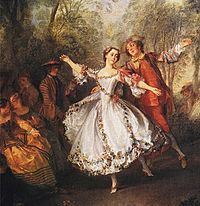Marie-Anne de Cupis de Camargo facts for kids
Marie Anne de Cupis de Camargo (born April 15, 1710, in Brussels – died April 28, 1770, in Paris), often called La Camargo, was a very famous French dancer. She was the first woman to perform a difficult ballet jump called the entrechat quatre. Camargo also helped change ballet costumes. She was one of the first dancers to wear soft slippers instead of shoes with heels. While she might not have been the very first, she helped make the shorter, calf-length ballet skirt popular, along with the ballet tights that dancers still wear today. People said she was as strong as the male dancers of her time.
Her Early Life
Camargo was born on April 15, 1710, in Brussels. Her parents were Ferdinand Joseph de Cupis and Marie-Anne de Smet. She had two younger brothers, Jean-Baptiste and François, who both became musicians. She also had a sister named Madeleine.
Her father was from Spain and worked as a violinist and dance teacher. He didn't earn much money. From a young age, Marie Anne was trained to perform on stage. When she was ten, she took lessons from Françoise Prévost, who was the top dancer at the Paris Opéra. Soon after, Camargo got a job as a main dancer, first in Brussels and then in Rouen.
Her Amazing Career

She performed for the first time in Paris on May 5, 1726, at the Paris Opera Ballet. The show was called Les Caractères de la Danse. Her teacher, Françoise Prévost, created the dance. Camargo impressed everyone with her amazing skills and lively energy. She performed difficult jumps and moves like entrechats and cabrioles perfectly. She became the first woman to do the entrechat quatre, and she quickly became very popular.
Camargo helped bring new ideas to ballet. She started wearing soft slippers instead of heeled shoes. She was also one of the first ballet dancers to make her skirt shorter, which later became the standard length. Everyone wanted to copy her style, and even her shoemaker became rich because of her tiny feet!
Her growing fame at the Paris Opera made her teacher, Prévost, jealous. Prévost moved Camargo to the back row of dancers. However, one day, a male dancer was missing, and Camargo bravely stepped in. She performed a brilliant solo without any practice. This amazing act made her a top ballerina.
She had many important fans. She retired from dancing for a few years, from 1736 to 1741. Then she returned to the stage from 1741 to 1751. After she finally retired, she received money from the government.
During her career, she performed in 78 ballets or operas. Audiences always loved her performances. The famous painter Nicolas Lancret painted a well-known picture of her. You can see versions of it in London and Washington, D.C. In these paintings, she is shown wearing heeled shoes and standing on her toes.
A ballet called Camargo was created about her life. It was based on a time when she and her sister were taken by the Comte de Melun in 1728. The famous ballerina Adèle Grantzow played Marie Anne Camargo in the first show on December 19, 1872.
Her Later Life and Death
Marie Anne de Cupis de Camargo died on April 28, 1770, in Paris. She passed away thirteen days after her 60th birthday.
See also
 In Spanish: Marie Anne de Cupis de Camargo para niños
In Spanish: Marie Anne de Cupis de Camargo para niños
- Camargo Society - A ballet company in London (1930–1933) named after La Camargo
- Women in dance
- Troupe of the Comédie-Française in 1755

